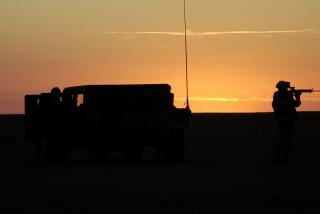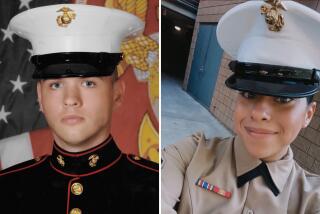Reality of Combat Hits U.S. Platoon
- Share via
FALLOUJA, Iraq — The two dead insurgent fighters lay face down in the muddy road.
“There must be [more] bad guys around here,” said Staff Sgt. Dennis Nash as he guided the 1st Platoon of Charlie Company past the bodies.
What followed was an hours-long series of firefights between the 1st Platoon and an often unseen rebel force firing from windows and alleyways in a neighborhood of stately two-story stucco houses and palm tree-lined streets.
Most residents appeared to have fled their homes in the upper-middle-class northern districts of Fallouja before the U.S. Marines began their assault.
No civilians were on the streets and many homes were already reduced to rubble, either from past U.S. airstrikes or an intensive barrage that preceded the attack on the rebel-held city.
“From what we’ve seen so far, the only people left are the bad guys,” said Lt. Christopher Conner, executive officer of Charlie Company, 1st Battalion, 8th Marine Regiment.
In their first day of combat in the current Fallouja assault, the Marines were met with sniper fire and mortar rounds as they swooped down from the north toward the center of the city.
“We’ve seen fire every step of the way,” said 1st Sgt. Jose Andrade, who compared the experience to the action he saw in Somalia.
Much of the 1st Platoon was pinned down for hours at a traffic circle immediately upon entering the city limits of Fallouja around midnight. Fighting the rain and cold as well as the unseen enemy, the Marines dug in to avoid rocket-propelled grenades and mortar and machine-gun fire.
At one point, the attack intensified and the Marines feared they had been encircled by an enemy invisible except for its tracer bullets and the impact of its rounds.
“They’re enveloping us,” Nash told his troops. “Everyone has to be on the alert.”
As dawn approached, the platoon was finally able to move forward, heading down a dark street where the two dead insurgent fighters were found on the ground. A third was gravely wounded and would die later. Most likely, Marines said, they were the victims of a U.S. airstrike.
After checking the bodies for booby traps and removing the weapons, the platoon moved on.
At daybreak, the shooting again began in earnest. At first, it appeared someone on a sidestreet had opened fire, but suddenly the bullets were whizzing from every direction.
“You train for this all the time,” said Lance Cpl. James Miller, “but until you experience it, it’s hard to know what it’s like.”
Looking for cover, the Marines commandeered one of the many empty houses -- a two-story whose roof had a cement wall around it and seemed to make for a good defensive position.
It didn’t take long for the troops to draw more fire. At some points, the rounds seemed to be coming from 360 degrees. The Marines fired hundreds of rounds back at the attackers.
“I see a sniper behind a curtain,” one Marine said as he spotted a foe and opened fire.
The insurgents, Marine commanders said, seemed comfortable striking at the Marines on home terrain. They know the streets and alleys -- and where their arms are stored. Indeed, many houses in Fallouja appeared to be nothing more than weapons caches.
“The enemy wants to draw us in, then strike on his terms,” said Lt. Matthew Rhoades, commander of Charlie Company.
Outside the house, a white car parked in a nearby alley drew the Marines’ attention. Dozens of cars were said to have been rigged with explosives meant to be detonated by remote control as Marine patrols passed.
The troops decided to fire at the car, which blew up, sending artillery shells and other munitions into the sky.
For the young Marines, such victories relieved some of the tension that had built up in recent weeks as they anticipated the invasion.
But then reality again intruded.
A team from Charlie Company left the house during a break in the fighting to remove some mortar tubes that had been set up in an adjacent field. As they looked down, however, they discovered a dead Marine from another unit. He’d been shot through the head by a sniper.
“It makes you realize how real this all is, how real the threat is,” said Lance Cpl. Shane Short.
For the rest of the afternoon, the platoon was more somber, and during a lull in the fighting, several Marines took a long-needed rest.
A sudden burst of gunfire roused them.
A group of six to eight insurgents had shown up on the street outside the building, poised to attack.
One made it as far as the front gate before he was shot dead from inside. His body lay there for the rest of the afternoon. Another was found dead nearby and the rest fled.
At dusk, the Marines finally left the house and headed to the Al Hadra al Muhammadiya mosque, a gathering point for insurgents that had just been seized by Charlie Company in conjunction with Iraqi government forces.
It was a walk of about 500 yards -- a dangerous expedition. This time, however, the 1st Platoon was joined by other squads, along with two Abrams tanks and a giant bulldozer.
The procession made its way slowly to the mosque, the menacing 60-ton tanks holding up the rear.
They arrived without incident.
And for once this day in Fallouja, not a shot was fired.
McDonnell is traveling with Charlie Company, 1st Battalion, 8th Marine Regiment.
More to Read
Sign up for Essential California
The most important California stories and recommendations in your inbox every morning.
You may occasionally receive promotional content from the Los Angeles Times.










